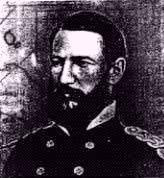Disciples of Christ
The Foreign Christian Missionary Society (FCMS) of the Disciples of Christ was formed in 1877. M/M Charles E. Garst and M/M George T. Smith answered their first call for missionary recruits for Japan. (For the full story of the Garsts, read his wife's book, A West Pointer in the Land of the Mikado 1913.)

Charles E. Garst
These two families, including the Smiths' young daughter, Elsie, sailed from San Francisco September 27, 1883 and arrived in Yokohama October 18, 1883 after a very rough voyage.
They settled in Akita Prefecture on the snow-driven northwest coast of Honshu, Japan's main island. Josephine Smith died there March 23, 1884, shortly after childbirth. Her infant daughter died a month later. Mrs. Smith's is the first missionary grave in northern Japan and the first Disciple missionary to give her life on a foreign field.
A year later the Garsts had their first convert and four years later they moved eighty miles south to the town of Tsurugaoka. They stayed there three years until furlough time. The churches the Garsts established in Akita and Honjo still exist today and will soon have their own hundredth anniversaries.
On return from furlough, the Garsts settled in Tokyo as a result of a change in missionary policy. A. McLean, President of the FCMS wrote (The History of the Foreign Missionary Society, 1919, p.201): "It was believed that a mission with its headquarters in the capital would have a prestige that it could not have otherwise . . . The plan adopted did not work out as well as it had been hoped."
Garst himself died in Tokyo during his second term of service, age 45, after a long illness. He had literally burned himself out in his missionary endeavors. He is buried in Aoyama Cemetery in central Tokyo.
It should be noted in passing that to this day the entire west coast of Honshu, hundreds of miles long, remains neglected by our people.
The Disciples' work in Tokyo expanded rapidly to Fukushima Prefecture and to the cities of Sendai in the north and Osaka in the south. Drake Bible College was started in 1903 on a large tract of land in Takinogawa near Tokyo. Middle schools and other institutions were started on this site in 1905 and 1906. Drake Bible college was closed in 1923 in favor of a union school which eventually became Tokyo Union Theological Seminary (Kyodan).
In 1940, the Disciples had 7 missionaries, 13 pastors, 19 churches, 2666 members and 35 baptisms. These churches joined the Kyodan (United Church of Christ of Japan) October 17, 1940. All Disciple mission properties and institutions also passed over to the Kyodan.
The 1956 report of the United Christian Missionary Society stated, "In regard to the churches themselves, together with the dozen or so kindergartens and other activities that they maintain, it would be misleading to speak of them as "our" churches because they consider themselves a part of the movement in Japan for the unity of God's people that comprises all of the 1450 congregations in the United Church. Within this great fellowship they are happy to be making their witness to their Bible-based beliefs, without any arrogant assumption that their understanding of the Bible is superior to that of others." (p.818, 1956 Year Book of Disciples of Christ).
Any Disciple missionaries now serving in Japan are working under the Japan North American Commission on Cooperative Mission. As missionaries under this Interboard Committee, their Disciple identities are unknown.
At present sixteen former Disciple churches belong to the Kyodan. Open membership is required by this group. Where immersion still continues for new members, it is done more as a remembrance of things past than out of scriptural convictions. All local ministers are appointed by Kyodan headquarters. Since it is now over 40 years since the Kyodan was formed, there are no Kyodan ministers now being appointed who were trained in Christian Church seminaries or who know anything about it.
Very old members remember their baptism by Disciple missionaries and some of them recall when there were thriving Disciple churches at every major railroad stop between Tokyo and Sendai, 200 miles to the north.
The International Convention of Churches of Christ pays the way for Kyodan delegates to its quadrenma gatherings in different parts of the world. It is a pleasant fiction to maintain that Kyodan churches are still churches of Christ while at the same time this con vention fails to recognize and represent independent churches of Christ beyond the United States and Canada. It is a free convention, however, so the independents are free to attend if they wish.
Pre-war, serving under the FCMS and later the UCMS, the Disciples had 44 married missionaries, 26 single missionaries and 15 who were independent but had some Disciple connection.
Post-war, serving entirely with the Kyodan, the Disciples have had 24 married missionaries and 13 single missionaries working in Japan.